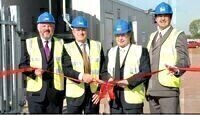Water/Wastewater
Membrane Bioreactor Leachate Treatment System
Aug 28 2008
kind in the UK incorporating Wehrle Environmental advanced
membrane technology has recently been installed for landfill
leachate treatment at Veolia`s Ockendon landfill site.
Terry Hipsey, Leader of Thurrock Council, officially opened the
plant. An invited audience were given an overview of the project by John O`Sullivan from Veolia, whilst Erwin Muehle (Managing Director, Wehrle Umwelt GmbH) and Tony Robinson (General Manager, from Wehrle Environmental UK) were in attendance to explain the technical details.
Tony Robinson said “We are delighted to have been able to work closely with Veolia to make this flagship UK project a reality. This project demonstrates that MBR technology provides a cost-effective solution to landfill leachate treatment, achieving a high quality permeate low in COD, ammonia and solids.â€
He added “Landfill leachate poses specific challenges for MBR technology, with high COD, ammonia and chloride levels. We needed to design a biological treatment system that extensively nitrified, whilst withstanding the corrosive chloride-rich influent.â€
At Ockendon, ammonia discharge consent limits to sewer had been limited to 100 kg/day in 2003 to ensure compliance levels set by the Environment Agency could be met. For the mean leachate production rate of 135 m3/day, an average permissible concentration of 750 mg/l ammonia was required for treated effluent. On-site treatment at Ockendon proved
necessary, since the leachate had high (up to 1100 mg/l) and fluctuating ammonia concentrations.
Veolia considered treatment systems from a number of contractors. Two were selected to undertake pilot trials to determine the treatment process required. Wehrle used one of their advanced pilot test systems in this evaluation, and after considering various membrane types
and configurations, it was concluded that the most cost-effective solution was to incorporate UF membrane technology. The biological process was "seeded" using activated sludge from a sequenced batch reactor and since commissioning the process has comfortably exceeded
the permeate water quality required.
Veolia selected Wehrle to undertake the project because of their professional and friendly approach, and their demonstrable expertise in landfill leachate treatment at numerous installations around the world. Also, Veolia were convinced that the technology would operate effectively (following the successful outcome of the pilot trials).
BecauseWehrle had undertaken detailed site investigations and pilot studies they were also able to design the process to meet the site conditions, especially tight space constraints.
Nick Sinclair, Veolia Project Manager, said “The limited space available on site and our 3 m height restriction were no problem for Wehrle.â€
Nick Sinclair also commented that Wehrle Environmental`s engineered solution represented excellent value for money for Veolia and he was impressed with the fully automated control system. He added “We were keen to install a system with low maintenance requirements, and with components resistant to the high chloride levels we have in the raw leachate.â€
On the future for MBR technology in landfill treatment, Tony Robinson commented that the market for leachate treatment is set to increase due to tightening ammonia consents. He said “The growth in the application of MBR technology is predicted to be high over the next few
years. Wehrle`s global expertise and proven track record in leachate treatment will help other landfill sites meet their environmental responsibilities.â€
Events
Apr 18 2024 Shanghai, China
Apr 22 2024 Hannover, Germany
Apr 23 2024 Kuala Lumpur, Malaysia
Apr 24 2024 Sao Paulo, Brasil
May 05 2024 Seville, Spain













